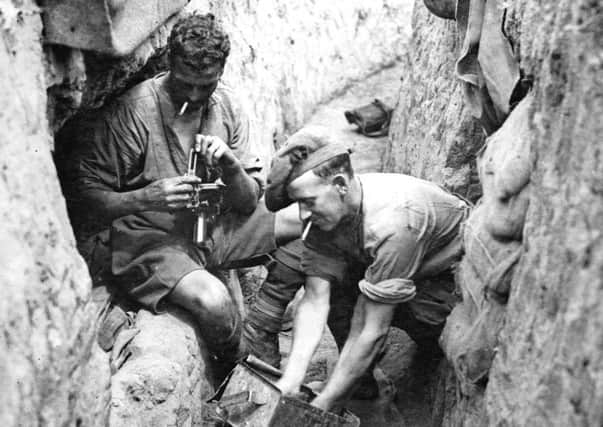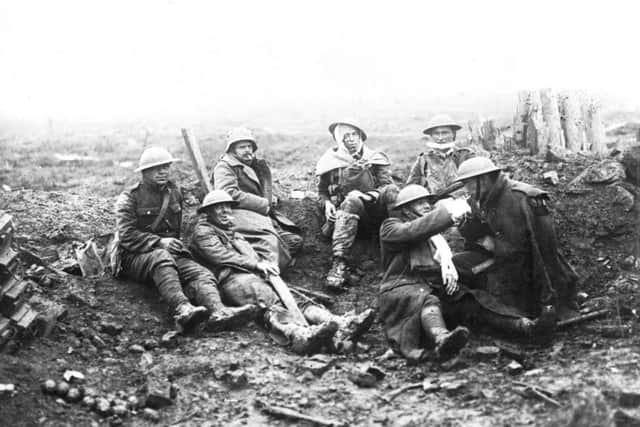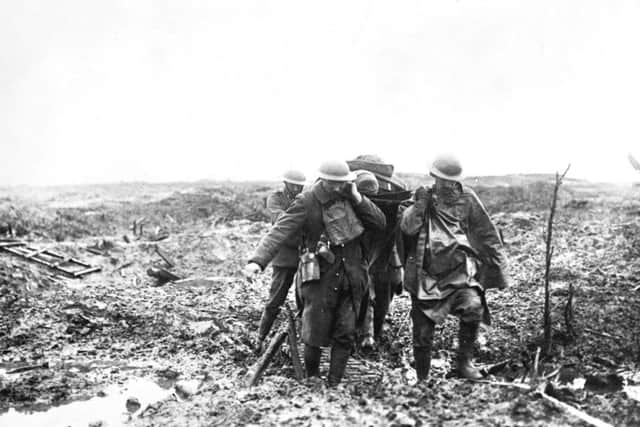Passchendaele: Music, faith and humour - how Scots soldiers sought comfort in the mud


In the midst of war’s collective misery, religious beliefs and spiritual experiences gave some the fortitude needed to face the horrors and terrors of long and bloody campaigns. The writer, and stretcher-bearer, Patrick MacGill, believed the brutality of war needed to be balanced with compassion and a right to exercise spiritual or religious beliefs. MacGill observed the needs of the dying, and their desperation to connect with a source which would give them succour. While collecting the injured from the battlefield at Loos he came across one dead German who, in the last throes of death, had apparently been attempting to connect with his family.
“I came across a crumpled figure of a man, one arm was bent under him and the other stretched forward almost touching a photograph of a woman and three little children. I placed the photograph under the edge of the man’s tunic. Near him lay another German, an old man, deeply wrinkled and white haired, and wounded through the chest. A rosary was in the man’s hand and his lips were mumbling something: he was telling his beads”.
Religion, talismans and lucky charms
Advertisement
Hide AdAdvertisement
Hide Ad

The war correspondent, Michael MacDonagh, reported that the use of religious objects or talismans had become commonplace. The wearing of religious emblems by soldiers of the British Army is much talked of by doctors and nurses in military hospitals in France and at home. When wounded soldiers are undressed – be they non-Catholic or Catholic - the discovery is frequently made of medals or scapulars worn around their necks, or sacred badges stitched inside their tunics. Furthermore, I have seen rosary beads twisted round rifle barrels.”
MacDonagh further reported on the enormous sales of a special lucky charm, “Touchwood”, specifically designed for soldiers. “Touchwood” is a tiny imp, mainly head, made of oak, surmounted by a khaki service cap, and with odd, sparkling eyes as if always on the alert to see and avert danger”. The designer, Mr. H. Brandon, sold 1,250,000 of this charm between 1914 and 1917.
The Army Chaplains’ Department did much to bring religious and moral strength to combatants and to comfort the fragile and distraught. However, men also sought and found their spirituality in meaningful gestures. A padre posted to a Scottish Regiment highlighted this need when soldiers discovered their much-loved senior officer was dead.
“We had one Major who was over six feet in height and broad with it, the men nicknamed him “MacDuff”. What a man he was - the men worshipped him. On a raiding party one night the Major received a wound to his abdomen and it was obvious the end was near. I shall never forget that night. Men called out, ‘Padre, MacDuff’s no deid! He’s no deid!’ More than one wept that night. We buried him at Montescourt. The raiding party made a coffin out of biscuit-box wood and lined it with tinfoil”.


Because of the huge number of deaths, coffins were impractical and soldiers were generally wrapped in their army blanket for burial; anything hand-made was a labour of love and deep respect.
Religious, spiritual and welfare needs were further catered for by the Young Men’s Christian Association (YMCA) and the Salvation Army. Both organisations concerned themselves with social and welfare benefits for the troops and dealt with queries regarding soldiers missing in action and prisoners of war. On the Home and Western Front, huts, canteens and marquees were set up to supply hot refreshments, reading rooms, games rooms, religious services and concerts. The YMCA facilities offered free writing paper and envelopes, and initiated the “Snapshot League” when it enrolled 11,000 amateur photographers to take pictures of soldiers’ and sailors’ families and friends.
The men were supplied with application forms, specifying who they wished to be photographed - wife, children, parents or other loved ones. The forms were returned to the YMCA in London, forwarded to the nearest volunteer photographer and the photographs were then dispatched in special waterproof envelopes; 500,000 photographs were sent out to the Western Front and the other fields of military operations.
Music played an inspiriting role, helping to sustain individual and troop morale. It was claimed that thousands of copies of the penny edition of “Camp Songs” were sold. It contained a collection of patriotic, humorous and sentimental songs, and prompted the “sing-along” or the “sing-song” in the YMCA huts and canteens. Concert parties were well attended and much appreciated. They were considered invaluable in raising troop morale, and gave men a psychological respite from the dangers of the trenches and the boredom of billets.
Advertisement
Hide AdAdvertisement
Hide Ad

Lena Ashwell, a well-known actress, produced concert parties for the troops at the front and they were usually held in YMCA huts. Ashwell remembers the first concert party. “The wooden hut was packed to suffocation… the men had been waiting for hours and smoking incessantly, and the fog of smoke and the heat within the hut was a tremendous contrast to the cold, rain and mud… Ivor Novello, who was one of the party, had just written ‘Keep the Home Fires Burning’, and when he sang it, the men seemed to drink it in at once and instantly sang the chorus, and as we drove away at the end of the concert, from all parts of the camp one could hear the refrain of the chorus”. Lena Ashwell performed in hospitals as well as YMCA huts and adapted her concert party’s repartee to suit the needs and wishes of the sick and wounded.
It was the little considerations for their welfare that uplifted or inspirited the troops. Mrs Henry Lee from Llandrindod sent lavender bags for the sick and wounded. An army chaplain serving at the Front wrote to her asking for 30,000 more. “I wish you could see how much the dainty little lavender bags mean to most of the wounded. Nearly every badly wounded and sick patient has a lavender bag pinned to his pillow and last night at least one man passed away with his little bag tightly clasped in his hand. Most of those who are evacuated are careful to take the little bag with them.”
Lady Smith-Dorrian’s Hospital Bag Fund met with equal success. The bags were made so that the sick or wounded could keep their personal possessions with them while in hospital. In a published report, Lady Smith-Dorrian claimed that with the generous support of 12,000 contributors she was able to respond to all the demands for Hospital Bags and two million were sent to the fighting fronts.
Getting it all on paper


Creative writing, particularly poetry became a form of self expression as it allowed men and women to describe the horrors of war without the fear of censorship. For some, there was a need to rationalise the slaughter which they believed was caused by military incompetence. Much of the poetry which emerged from their experiences dealt with spirituality, comradeship, God, insanity, disability, animals and nature. For the benefit of the public, alienated from the war and receiving sanitised reports on its conduct, the war poets wrote with first-hand experience about what life and death was really like on the fighting fronts.
Trench journalism was rife and was yet another form of creative writing that allowed the men to abandon army etiquette and rank. The purpose of trench journals was to amuse, criticise and grouse. The British and Dominion Forces produced over one hundred journals with the titles reflecting many of the sentiments and situations — The Rum Issue, Mules Monthly, The Whizz Bang, The Iodine Chronicle, The Poultice, and The Dug Out Despatch.
Whatever their content, they provided much needed light relief from the brutality of war and they provided a platform for satirising those who brought them into the war and who kept and controlled them within it.
Forming bonds where they could
Denied the warmth and closeness of family relationships, the forces found the innocence and vulnerability of animals provided comfort and an antidote to the brutalising effect of war. Stray or abandoned dogs and cats were adopted and according to one army captain, his company acquired an Aberdeen terrier which they found in a desolated village. The men named the dog “Jock” and he stayed with the company for months before he disappeared. Weeks later and eighty miles from where they had last seen “Jock”, he turned up. According to the captain, “Great was our joy and our beloved “Jock” went back to Britain with the battalion where he lived to a ripe old age”.
Nurses too adopted stray dogs and cats which were unofficially kept at their billets and base hospitals. To help raise the morale of patients it was not unusual for canaries to be kept on Ambulance Trains. Furthermore, some trains adopted cats as their mascots and they too travelled back and forth with the sick and wounded.
Advertisement
Hide AdAdvertisement
Hide AdFor those who smoked, tobacco relieved their frustrations, anxieties, fears, and boredom. Families regularly sent “smokes” or “gaspers” to their loved ones and they were invariably shared with comrades. The tobacco industry did very well out of the war; between 1910 and 1919, cigarette production increased by 633% from 10 billion per year to 70 billion per year. However, the exchange of letters and postcards from home was probably the greatest comfort of all and by 1917 the Army on the Western Front was receiving 12,000,000 letters and 1,000,000 parcels each week. At the front, 8,150,000 letters a week were sent home.
Humour and wry wit was an essential component for survival. When asked by the enquiring public what life was “really like at the front” the soldiers often retorted, “Apart from suffering from cheerfulness?” Thankfully, for them, humour did not die in the trenches.